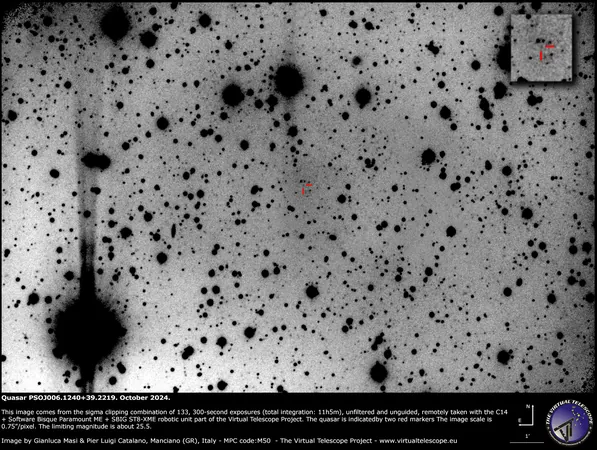
Breaking Astronomical Boundaries: Virtual Telescope Project Captures Record-Setting Quasar at the Edge of Space!
2024-11-04
Author: Yu
A groundbreaking achievement has emerged from the Virtual Telescope Project, pushing the limits of what’s possible in astronomy. Founded by astrophysicist Gianluca Masi, this innovative initiative has made an astonishing observation that extends our view into the very depths of the cosmos.
Last April, the project garnered attention by successfully capturing the distant quasar SDSS J114816.64+525150.3 using a modest 350mm telescope, which represents the most distant object observable in visible light. However, the team has recently surpassed this impressive feat by setting its sights even further into the universe.
In a remarkable display of determination and skill, Masi and his team turned their attention to the quasar PSO J006.1240+39.2219, a celestial body first discovered in 2017 with a staggering redshift of z=6.62. This redshift signifies its immense distance from Earth, making it 0.2 points more distant than the previous record-holder. Though it may seem like a small numerical difference, capturing this object marks a monumental challenge in astronomical observation.
Redshift, a phenomenon where light emitted from an object moving away stretches into longer wavelengths, has left this quasar's light beyond the visible spectrum, shifting it into the infrared. This means the PSO J006.1240+39.2219 appears faint and is much harder to detect than its predecessors.
Defying expectations, the Virtual Telescope Project's team undertook the arduous task of observing this distant quasar. In October 2024, employing their state-of-the-art 350mm telescope, they amassed an impressive collection of 133 images over a five-hour period, accumulating a total exposure time of 11 hours—an increase of 65% over prior attempts.
Despite the challenges presented by the faintness of the object and its position outside of the visible spectrum, the team relied on the telescope's camera, which is still sensitive to near-infrared wavelengths. The result? An astonishing image showcasing the faintest stars recorded at a magnitude of 25.5, a true testament to the capabilities of their equipment.
Gianluca Masi proudly notes, “To our knowledge, no telescope with a diameter under 180 cm has observed so deeply into space and time. He attributes much of their success to the pristine observing conditions at Manciano, Italy, one of the least light-polluted locations in the country.
The light from quasar PSO J006.1240+39.2219 has traveled an astonishing 12.9 billion years to reach us, emerging from an era when the universe was only 800 million years old. This period corresponds to the Epoch of Reionization, a critical phase in cosmic history marked by the energies released from the first stars and galaxies.
Quasars, the brilliant cores of distant galaxies powered by supermassive black holes, are among the brightest celestial objects we can observe. The quasar in question hosts a rapidly accreting supermassive black hole, which measures 200 million times the mass of our Sun, indicating it is still in its formative stages—a notable finding, considering typical high-redshift quasars have black holes 3 to 4 times more massive.
This remarkable achievement not only highlights the incredible capabilities of the Virtual Telescope Project but also reinforces Manciano’s position as a focal point for astronomical discovery. Over the past year, the project has also identified a probable nova in the Andromeda Galaxy and investigated new blazar candidates, further solidifying its reputation in the scientific community.
Founded in 2006, the Virtual Telescope Project has harnessed cutting-edge technology to bring stunning astronomical phenomena to global audiences through live online sessions. Its contributions have earned the recognition of international media and scientific organizations, showcasing the remarkable synergy between technology and outreach in the domain of astronomy.
With this new record, the Virtual Telescope Project is not just observing the cosmos; they are redefining our understanding of it. Who knows what other cosmic mysteries await us under the watchful gaze of this groundbreaking initiative? Stay tuned for more stellar discoveries!


 Brasil (PT)
Brasil (PT)
 Canada (EN)
Canada (EN)
 Chile (ES)
Chile (ES)
 España (ES)
España (ES)
 France (FR)
France (FR)
 Hong Kong (EN)
Hong Kong (EN)
 Italia (IT)
Italia (IT)
 日本 (JA)
日本 (JA)
 Magyarország (HU)
Magyarország (HU)
 Norge (NO)
Norge (NO)
 Polska (PL)
Polska (PL)
 Schweiz (DE)
Schweiz (DE)
 Singapore (EN)
Singapore (EN)
 Sverige (SV)
Sverige (SV)
 Suomi (FI)
Suomi (FI)
 Türkiye (TR)
Türkiye (TR)